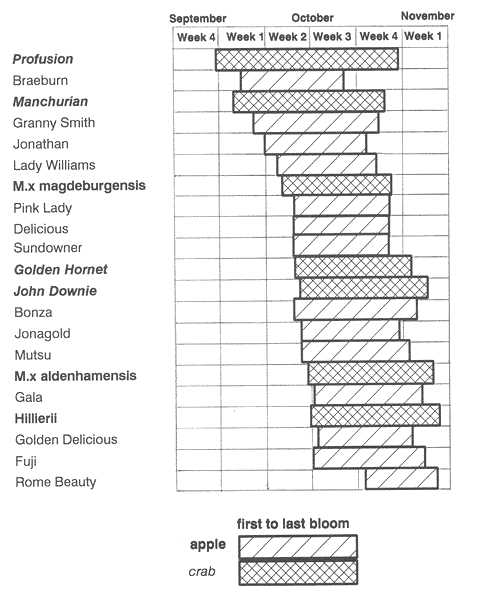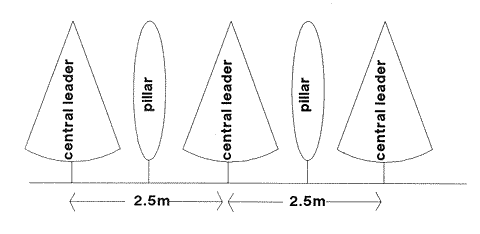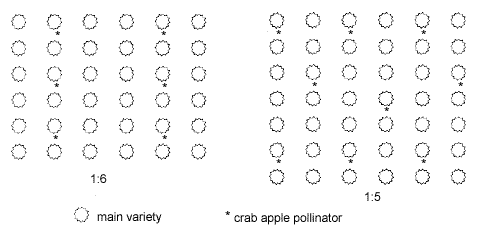
Crabapples as pollinators
Series: Agnote 4-77 Edition: First edition Last updated: Jan 2007
Introduction
Crab apples are usually regarded as ornamentals that are mainly used as garden showpieces. However, in recent years interest has focused more on their value as being pollinators for apple varieties, with worldwide research directed at testing their usefulness and effectiveness for this job. So how can crab apples be used to increase management flexibility in allowing a greater choice of pollinators for apples?
Choosing the pollinator is not often a simple decision, and the following factors need consideration:
- pollination ratio;
- compatibility of pollen and flowering times;
- ease of cultural management;
- spacing and placement in either solid rows or as single trees;
- marketability of pollinator fruit;
- honeybee activity and flower type preference, especially flower colour.
Some orchardists prefer to use a pollinating variety whose fruit is completely different from the main crop. Either this pollinator matures much earlier and is picked separately, or its fruit has a different colour. The use of Granny Smith as the pollinator for a Red Delicious block will allow for easier picker discrimination between the red and green coloured fruit, and this would avoid the two varieties being mistakenly picked and mixed in the bin. This problem could occur with Red Delicious being pollinated by Bonza. However, with a typical pollination ratio of 1:9, 10 per cent of the fruit will be of the pollinator variety, which means finding suitable market outlets for small lines of this fruit.
High-density orchard blocks have minimal surplus space and there can be problems associated with using solid rows. Usually bees work down the closer planted row, which reduces the likelihood of cross-pollination across rows, resulting in decreased yields and or misshapen fruit. Scattering pollinators through the rows overcomes this problem, but other management problems may arise, such as different thinning requirements or having mixed fruit at harvest.
For varieties which flower much earlier, such as Braeburn, using crab apples could help overcome the problem of providing a good source of pollen when no other varieties are available.
Suitable crab apple varieties
Although a crab apple flowers at the correct time and the pollen is shown to be compatible from hand pollination tests, this does not necessarily mean that it is the best one. Research conducted in the United States and at Orange in NSW has shown that bees, when out foraging apple blossoms, tend to stay with the same colour flower and fly past a different colour, especially if the blossom colours are very different, such as deep red or white with a tinge of pink. This could negate cross-pollination. Although there are reports of using a red crab apple variety in New Zealand, pollination there is carried out by both honey bees and bumble bees. We have no bumble bees in Australia, and we rely on honey bees for most pollination.
Most crab apples have quite a long flowering period due to spur flowers opening first, followed by one-year-wood flowers. Delicious varieties tend to flower only on spurs, but many other varieties flower on spurs and one-year wood. Spur flowers when set tend to produce larger fruits of more even good quality, rather than a mixture of fruit on spur and one-year-old wood, for storage as well as for grading.
Here are the best varieties of crab apple pollinators in terms of timing of flowering, from a wide range of commonly available species.
White flower types with a touch of pink
White flowers with varying amounts of pink are treated as the same colour by bees. The following three are the most suitable because of flower colour and honeybee activity.
Manchurian
- Fairly large white flowers with pale pink buds.
- Prolific flowering on one-year wood.
- Upright tree habit.
- Suitable for Braeburn, Granny Smith, king flowers of Delicious as well as many others, but it may be too early for Fuji and Gala.
Golden Hornet
- Medium white with deep pink bud.
- Upright tree habit.
- Mostly suitable for Fuji, Gala, Jonagold and Delicious, but in certain seasons may miss some king flowers.
John Downie
- Medium white with a touch of pink in the bud.
- Tallish spreading tree habit.
Pink flower types
Pink flowers are more intermediate for crossing with white. Some bees will bypass the colour but others will also cross from colour to colour.
M. × magdeburgensis
- Large pink semi-double flower with same colour in the bud.
- Spreading tree habit.
- Good timing for Delicious but late for Braeburn.
Hillierii
- Smallish pale pink.
- Very prolific flowering.
- Spreading and weeping tree habit.
- Good timing for Delicious but late for Braeburn.
Red or winey red flower types
Bees tend to forage flowers of a similar colour, so different colours are less likely to be cross-pollinated.
M. × aldenhamensis
- Medium winey red with a deep red bud.
- Spreading tree habit.
- Later flowering that will probably miss Delicious king flowers, but could be suitable for Gala, Fuji and Jonagold.
Profusion
- Medium to large bright red with deep red buds.
- Spreading tree habit.
- Wide spread of flowering from very early to mid-late, and could be more useful for early flowering varieties such as Braeburn, Granny Smith or Jonathan.
Comparing the spread of bloom
A comparison of the spread of bloom for the major apple varieties and these crab apples is found in Table 1. These times are based on observations made at Orange in NSW, which would be similar for Batlow (NSW), but the times would be earlier by 1–2 weeks for other NSW districts. The order of flowering would not change significantly from district to district.

Managing crab apples
There are many advantages in using crab apples. The most significant is that because crabs produce such small fruit they are not easily mistaken, and there is usually no need to worry about picking or thinning the wrong variety. Also they bear on one-year wood, which means they can be pruned each year after flowering and still produce an abundance of flowers for next season. Being slightly smaller than most other varieties, crab apple trees do not need a full tree space and so can be planted at higher pollination densities as single trees within the row.
The ideal management of crab apples is as follows:
- Choose the crab apple most suited for the variety. If there is a risk of crab flowers not coming out in time for the king flowers in a certain season, alternating with two crabs should help overcome this problem.
- Crabs can be planted on the same or slightly more vigorous rootstock than the variety.
- Interplant crabs at half the tree-spacing distance, provided this is not less than 2.5 m.
- Allow the crab apples to flower each year as normal.
- After flowering, prune the crabs and remove most one-year wood. Some spurs should be retained so as to provide enough blossoms from the first opened king flowers to the later blossoming lateral flowers of the pollinated variety. Some crab apple fruit set will not matter, as this will avoid the risk of biennial bearing. New wood should be encouraged for the production of strong bushy growth which will flower the following year. Having to worry about thinning or harvesting should not be necessary.
- Encourage a pillar shape so that there is little crowding of either the crab or neighbouring trees. The pillar shape should be almost as tall as the main variety so that bees will fly from tree to tree throughout the foliage canopy, from crab to variety to crab etc. This is shown in Figure 1.
- Use a higher pollination ratio of either 1:5 or 1:6 to counter the interplanting and a possible shading problem. This is shown in Figure 2.


Author: Delia Dray, Jill Campbell

